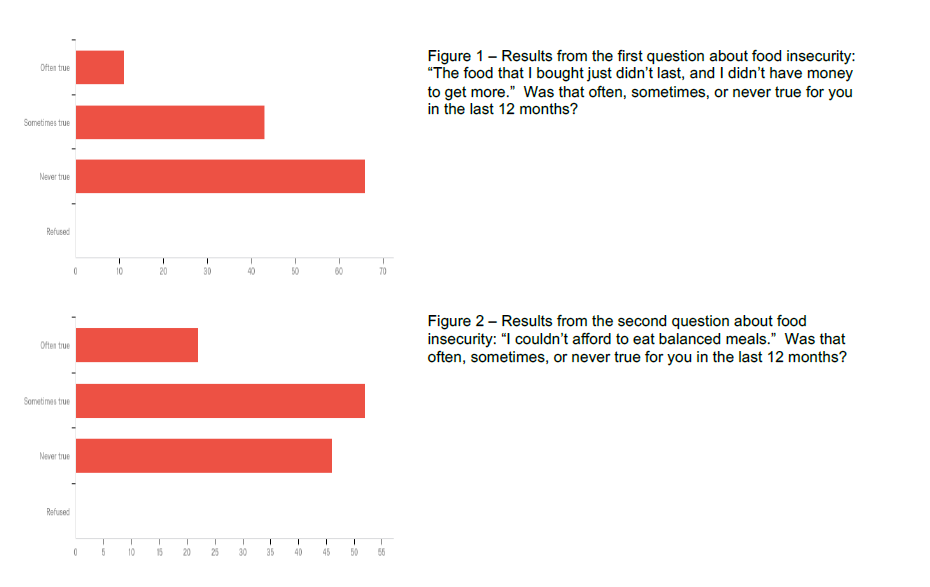Kielee Wiser and Faculty Mentor: Neil Peterson, College of Nursing
The purpose of this project was to assess food insecurity among college students
attending Brigham Young University (BYU). Food insecurity is the lack of consistent
access to food, which has become an increasing problem among college students
throughout the United States. The lack of food can contribute to poor performance in
school, health complications, and homelessness.
In order to analyze the possible problem of food insecurity among students at BYU, a
quantitative analysis was conducted using a Qualtrics survey. Nine of the questions in
the survey were demographic, while the remaining six were taken from a well-validated,
extensively-used survey from previous researchers assessing food insecurity. Students
were invited, via email, to participate in the survey for a change to win one of ten $25
Amazon gift cards. The study concluded with 127 participants.
Some of the questions in the survey directly pertaining to food insecurity were:
(1) “The food that I bought just didn’t last, and I didn’t have money to get more.”
Was that often, sometimes, or never true for you in the last 12 months? (2) “I
couldn’t afford to eat balanced meals.” Was that often, sometimes, or never true
for you in the last 12 months? (3) In the last 12 months, did you/you or other
adults in your household ever cut down on the size of your meals or skip meals
because there wasn’t enough money for food?
These questions, along with a few others, allowed us to assess how many students
were currently experiencing difficulty with the lack of food. It was not surprising to see
the majority, 55%, selected “never true” for the first question. However, 36% marked
this as “sometimes true” and 9% selected “often true.” For the second question, the
majority, 44%, selected “sometimes true” in regards to not being able to eat balanced
meals. 28% selected “often true” and 38% chose “never true.” The third questions
resulted with 64% of participants selecting “no,” while the remaining 36% chose “yes.”
For those who selected “yes,” another question followed asking how often the
participant experienced cutting down or skipping meals. Of the 36% who answered
“yes” to the third question, 37% of students selected “almost every month,” 32% chose
“some months but not every month,” and the remaining 30% picked “only 1 or 2
months.” This evidence suggests food insecurity is a growing problem at BYU that
needs to be addressed.
Some factors that may contribute to food security with BYU students include: living at
home with parents and living on campus. Those living at home may not be
experiencing a lack of food due to parents providing meals. Students living on campus
housing often have a meal plan and most likely are not facing food insecurity. Our
results indicate 14% of students live at home with their parents and 18% live on
campus.
Further analysis revealed a difference in food insecurity levels among students who
were single, engaged, and married. In accordance to the second question about not
being able to afford to eat balanced meals, single students were the population with the
least amount of food insecurity. 42% of these students checked “never true,” 19%
selected “often true,” and 40% chose “sometimes true.” Married students came in
second for experiencing food insecurity. 30% of students chose “never true,” 13%
checked “often true,” and 57% selected “sometimes true.” Food insecurity was most
applicable to engaged students attending BYU. 17% selected “never true,” 33% chose
“often true,” and 50% checked “sometimes true.”
This project was valuable because it was the first study done to assess the level of food
insecurity with students at BYU. While further research is needed to tell the true
magnitude of these results, it could be hypothesized that more students are
experiencing food insecurity. In order to obtain these results, a larger scale study would
need to be conducted.
The goal of this project was to assess the issue of food insecurity of students attending
BYU, and gain a deeper understanding of the problem. While many students reported
food insecurity was not a problem, there were others (especially those who were
engaged and married) who reported a lack of food, eating less due to budget
constraints, and not eating balanced meals. It can be concluded that further research is
needed in order to better comprehend the severity of food insecurity among BYU
students.

